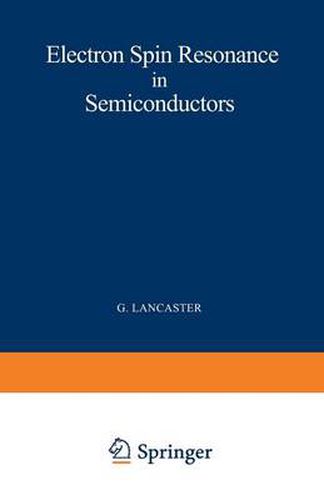Readings Newsletter
Become a Readings Member to make your shopping experience even easier.
Sign in or sign up for free!
You’re not far away from qualifying for FREE standard shipping within Australia
You’ve qualified for FREE standard shipping within Australia
The cart is loading…






This title is printed to order. This book may have been self-published. If so, we cannot guarantee the quality of the content. In the main most books will have gone through the editing process however some may not. We therefore suggest that you be aware of this before ordering this book. If in doubt check either the author or publisher’s details as we are unable to accept any returns unless they are faulty. Please contact us if you have any questions.
Since the study of the solid state began it has been necessary to use increasingly refined experimental techniques, of which electron spin resonance is an important example, in the effort to gain information concerning the structure and properties of an immense and varied range of solids. In the last two decades the great commercial demand for solid-state electronic devices has stimulated research into the funda mental properties of semiconductors. At the same time as semiconductor devices were becoming techno logically important, the technique of electron spin resonance was first being used on a large scale, principally at the Clarendon Laboratory, Oxford. Both solid-state physics and electron spin resonance have now reached the stage where they are useful to each other, primarily in the realm of the atomic properties of matter. Dr Lancaster’s book is one of a series of monographs that aims at covering as comprehensively as possible the field of electron spin resonance. His book has been written for those who wish to know some thing about the way in which the electron spin resonance technique has been used in the study of semiconductors. It also has value for specialists who may need an authoritative work of reference, and for workers in allied subjects who wish to use this technique to further their work. Much of his treatise deals with electron spin resonance in crystals of silicon and germanium containing specific impurities, as these materials are of greatest interest. Practical results are discussed wherever possible.
$9.00 standard shipping within Australia
FREE standard shipping within Australia for orders over $100.00
Express & International shipping calculated at checkout
This title is printed to order. This book may have been self-published. If so, we cannot guarantee the quality of the content. In the main most books will have gone through the editing process however some may not. We therefore suggest that you be aware of this before ordering this book. If in doubt check either the author or publisher’s details as we are unable to accept any returns unless they are faulty. Please contact us if you have any questions.
Since the study of the solid state began it has been necessary to use increasingly refined experimental techniques, of which electron spin resonance is an important example, in the effort to gain information concerning the structure and properties of an immense and varied range of solids. In the last two decades the great commercial demand for solid-state electronic devices has stimulated research into the funda mental properties of semiconductors. At the same time as semiconductor devices were becoming techno logically important, the technique of electron spin resonance was first being used on a large scale, principally at the Clarendon Laboratory, Oxford. Both solid-state physics and electron spin resonance have now reached the stage where they are useful to each other, primarily in the realm of the atomic properties of matter. Dr Lancaster’s book is one of a series of monographs that aims at covering as comprehensively as possible the field of electron spin resonance. His book has been written for those who wish to know some thing about the way in which the electron spin resonance technique has been used in the study of semiconductors. It also has value for specialists who may need an authoritative work of reference, and for workers in allied subjects who wish to use this technique to further their work. Much of his treatise deals with electron spin resonance in crystals of silicon and germanium containing specific impurities, as these materials are of greatest interest. Practical results are discussed wherever possible.